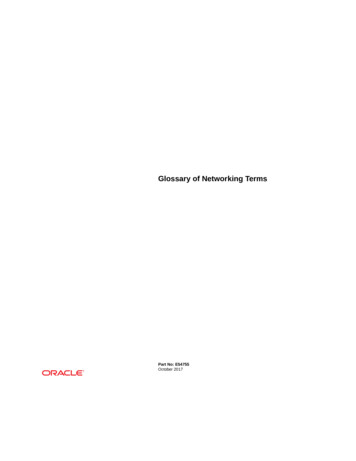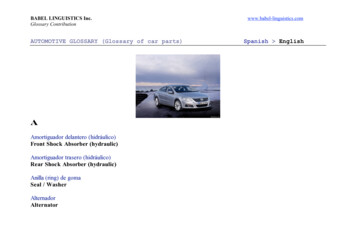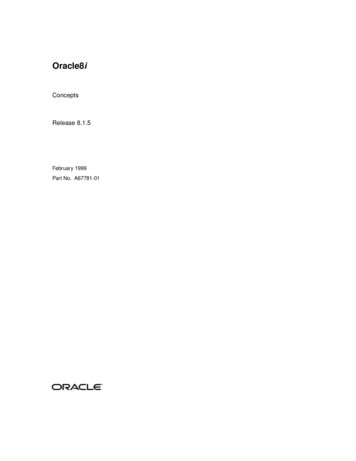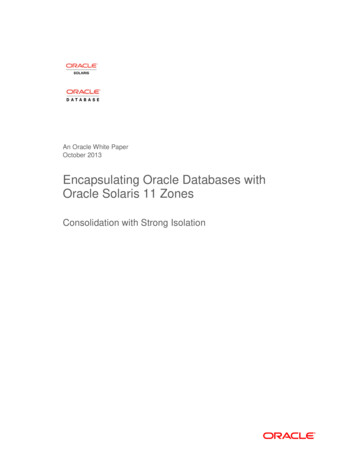
Transcription
Glossary of Networking TermsPart No: E54755October 2017
Glossary of Networking TermsPart No: E54755Copyright 2011, 2017, Oracle and/or its affiliates. All rights reserved.This software and related documentation are provided under a license agreement containing restrictions on use and disclosure and are protected by intellectual property laws. Exceptas expressly permitted in your license agreement or allowed by law, you may not use, copy, reproduce, translate, broadcast, modify, license, transmit, distribute, exhibit, perform,publish, or display any part, in any form, or by any means. Reverse engineering, disassembly, or decompilation of this software, unless required by law for interoperability, isprohibited.The information contained herein is subject to change without notice and is not warranted to be error-free. If you find any errors, please report them to us in writing.If this is software or related documentation that is delivered to the U.S. Government or anyone licensing it on behalf of the U.S. Government, then the following notice is applicable:U.S. GOVERNMENT END USERS: Oracle programs, including any operating system, integrated software, any programs installed on the hardware, and/or documentation,delivered to U.S. Government end users are "commercial computer software" pursuant to the applicable Federal Acquisition Regulation and agency-specific supplementalregulations. As such, use, duplication, disclosure, modification, and adaptation of the programs, including any operating system, integrated software, any programs installed on thehardware, and/or documentation, shall be subject to license terms and license restrictions applicable to the programs. No other rights are granted to the U.S. Government.This software or hardware is developed for general use in a variety of information management applications. It is not developed or intended for use in any inherently dangerousapplications, including applications that may create a risk of personal injury. If you use this software or hardware in dangerous applications, then you shall be responsible to take allappropriate fail-safe, backup, redundancy, and other measures to ensure its safe use. Oracle Corporation and its affiliates disclaim any liability for any damages caused by use of thissoftware or hardware in dangerous applications.Oracle and Java are registered trademarks of Oracle and/or its affiliates. Other names may be trademarks of their respective owners.Intel and Intel Xeon are trademarks or registered trademarks of Intel Corporation. All SPARC trademarks are used under license and are trademarks or registered trademarks ofSPARC International, Inc. AMD, Opteron, the AMD logo, and the AMD Opteron logo are trademarks or registered trademarks of Advanced Micro Devices. UNIX is a registeredtrademark of The Open Group.This software or hardware and documentation may provide access to or information about content, products, and services from third parties. Oracle Corporation and its affiliates arenot responsible for and expressly disclaim all warranties of any kind with respect to third-party content, products, and services unless otherwise set forth in an applicable agreementbetween you and Oracle. Oracle Corporation and its affiliates will not be responsible for any loss, costs, or damages incurred due to your access to or use of third-party content,products, or services, except as set forth in an applicable agreement between you and Oracle.Access to Oracle SupportOracle customers that have purchased support have access to electronic support through My Oracle Support. For information, visit http://www.oracle.com/pls/topic/lookup?ctx acc&id info or visit http://www.oracle.com/pls/topic/lookup?ctx acc&id trs if you are hearing impaired.
Référence: E54755Copyright 2011, 2017, Oracle et/ou ses affiliés. Tous droits réservés.Ce logiciel et la documentation qui l'accompagne sont protégés par les lois sur la propriété intellectuelle. Ils sont concédés sous licence et soumis à des restrictions d'utilisation etde divulgation. Sauf stipulation expresse de votre contrat de licence ou de la loi, vous ne pouvez pas copier, reproduire, traduire, diffuser, modifier, accorder de licence, transmettre,distribuer, exposer, exécuter, publier ou afficher le logiciel, même partiellement, sous quelque forme et par quelque procédé que ce soit. Par ailleurs, il est interdit de procéder à touteingénierie inverse du logiciel, de le désassembler ou de le décompiler, excepté à des fins d'interopérabilité avec des logiciels tiers ou tel que prescrit par la loi.Les informations fournies dans ce document sont susceptibles de modification sans préavis. Par ailleurs, Oracle Corporation ne garantit pas qu'elles soient exemptes d'erreurs et vousinvite, le cas échéant, à lui en faire part par écrit.Si ce logiciel, ou la documentation qui l'accompagne, est livré sous licence au Gouvernement des Etats-Unis, ou à quiconque qui aurait souscrit la licence de ce logiciel pour lecompte du Gouvernement des Etats-Unis, la notice suivante s'applique :U.S. GOVERNMENT END USERS: Oracle programs, including any operating system, integrated software, any programs installed on the hardware, and/or documentation,delivered to U.S. Government end users are "commercial computer software" pursuant to the applicable Federal Acquisition Regulation and agency-specific supplementalregulations. As such, use, duplication, disclosure, modification, and adaptation of the programs, including any operating system, integrated software, any programs installed on thehardware, and/or documentation, shall be subject to license terms and license restrictions applicable to the programs. No other rights are granted to the U.S. Government.Ce logiciel ou matériel a été développé pour un usage général dans le cadre d'applications de gestion des informations. Ce logiciel ou matériel n'est pas conçu ni n'est destiné à êtreutilisé dans des applications à risque, notamment dans des applications pouvant causer un risque de dommages corporels. Si vous utilisez ce logiciel ou ce matériel dans le cadred'applications dangereuses, il est de votre responsabilité de prendre toutes les mesures de secours, de sauvegarde, de redondance et autres mesures nécessaires à son utilisation dansdes conditions optimales de sécurité. Oracle Corporation et ses affiliés déclinent toute responsabilité quant aux dommages causés par l'utilisation de ce logiciel ou matériel pour desapplications dangereuses.Oracle et Java sont des marques déposées d'Oracle Corporation et/ou de ses affiliés. Tout autre nom mentionné peut correspondre à des marques appartenant à d'autres propriétairesqu'Oracle.Intel et Intel Xeon sont des marques ou des marques déposées d'Intel Corporation. Toutes les marques SPARC sont utilisées sous licence et sont des marques ou des marquesdéposées de SPARC International, Inc. AMD, Opteron, le logo AMD et le logo AMD Opteron sont des marques ou des marques déposées d'Advanced Micro Devices. UNIX est unemarque déposée de The Open Group.Ce logiciel ou matériel et la documentation qui l'accompagne peuvent fournir des informations ou des liens donnant accès à des contenus, des produits et des services émanant detiers. Oracle Corporation et ses affiliés déclinent toute responsabilité ou garantie expresse quant aux contenus, produits ou services émanant de tiers, sauf mention contraire stipuléedans un contrat entre vous et Oracle. En aucun cas, Oracle Corporation et ses affiliés ne sauraient être tenus pour responsables des pertes subies, des coûts occasionnés ou desdommages causés par l'accès à des contenus, produits ou services tiers, ou à leur utilisation, sauf mention contraire stipulée dans un contrat entre vous et Oracle.Accès aux services de support OracleLes clients Oracle qui ont souscrit un contrat de support ont accès au support électronique via My Oracle Support. Pour plus d'informations, visitez le site http://www.oracle.com/pls/topic/lookup?ctx acc&id info ou le site http://www.oracle.com/pls/topic/lookup?ctx acc&id trs si vous êtes malentendant.
ContentsUsing This Documentation . 7Glossary . 95
6Glossary of Networking Terms October 2017
Using This Documentation Overview – Provides definitions of common networking terms and acronyms used in thecontext of Oracle Solaris networking.Audience – System administrators.Required knowledge – Basic and some advanced network administration skills.Product Documentation LibraryDocumentation and resources for this product and related products are available at http://www.oracle.com/pls/topic/lookup?ctx E53394-01.FeedbackProvide feedback about this documentation at http://www.oracle.com/goto/docfeedback.Using This Documentation7
8Glossary of Networking Terms October 2017
Networking Terms in Oracle SolarisThis glossary defines commonly used networking terms and acronyms in Oracle Solaris to assist anyone inwriting white papers, specifications, and user and training documentation and to help ensure consistent usage.This glossary does not include an exhaustive list of terms that generally apply to all of networking. Also, many ofthe terms in this glossary are specific to Oracle Solaris networking technologies.3DES(Triple-Data Encryption Standard) A symmetric-key encryption method that applies the DataEncryption Standard (DES) cipher algorithm to encrypt data three times. 3DES requires a keylength of 168 bits. 3DES is also referred as Triple-DES.6to4An automatic tunneling mechanism that transfers IPv6 packets over an IPv4 network. 6to4tunnels enable isolated IPv6 sites to communicate across an automatic tunnel over an IPv4without the need to configure explicit tunnels.AAddressResolutionProtocolSee ARP.AdvancedEncryptionStandardSee AES.AES(Advanced Encryption Standard) A symmetric 128-bit block data encryption technique. AES isthe U.S. government encryption standard.anet resourceA VNIC or an IPoIB partition datalink that is configured by using the zonecfg command forOracle Solaris Zones and instantiated when the zone boots. See also VNIC.Glossary9
anycast addressanycastaddressAn IPv6 address that is assigned to a group of interfaces, usually belonging to different nodes.A packet that is sent to an anycast address is routed to the nearest interface having that address.The packet's route is in compliance with the routing protocol's measure of distance.anycast groupA group of interfaces with the same anycast IPv6 address. The Oracle Solaris implementationof IPv6 does not support the creation of anycast addresses and groups. However, Oracle SolarisIPv6 nodes can send traffic to anycast groups.ARP(Address Resolution Protocol) A protocol that provides dynamic mapping between IPaddresses and the Ethernet addresses. ARP is used with IPv4 networks only. IPv6 networks usethe Neighbor Discovery Protocol for translating protocol addresses. For more information, seeRFC 826 ryptographyAn encryption system in which the sender and receiver of a message use different keys toencrypt and decrypt the message. Asymmetric keys can be used to establish a secure channelfor symmetric key encryption. The Diffie-Hellman protocol is an example of an asymmetrickey protocol.asymmetricroutingOccurs when a packet travels from a source to a destination in a path but takes a different pathwhile returning to the source. Commonly seen in the Layer-3 (network layer) routed networks.asynchronousPPPA form of PPP over asynchronous serial lines, which transfer data one character at a time.The most common form of PPP configuration, the dial-up link, uses asynchronous PPPcommunications.authenticationThe act of verifying the identity that is supplied over the network by a remote user or entity,such as a program.authenticationheaderAn extension header that provides authentication and integrity without confidentiality to IPdatagrams.autonegotiation An Ethernet procedure in which two connected devices share their capabilities regardingtransmission parameters, such as speed, duplex mode, and flow control. The connected devicesuse the highest performance transmission mode that they support.autonomoussystemA single routing domain that is used for administering the network topology of sites withmultiple routers and networks. This routing domain is a connected group of one or more IPprefixes and has a single and clearly defined routing policy. For more information, see RFC1930 (http://tools.ietf.org/html/rfc1930).Bbackup router10A VRRP instance for a VRID that is active but not in the master state is called a backup router.Any number of backup routers can exist for a VRID. A backup router assumes the role of amaster router if the current master router fails. See also VRRP and VRID.Glossary of Networking Terms October 2017
CBCPbandwidthcontrolEnables you to control the available bandwidth of a physical NIC on a per-application, perport, per-protocol, and per-address basis.bandwidthdelay productDetermines the amount of data sent through the network. This data is the product of theavailable network bandwidth and the connection latency or round-trip time.bandwidthshareThe minimum share of the bandwidth that the VNIC will get when there is competition fromother VNICs on the same datalink.BGP(Border Gateway Protocol) A protocol that exchanges routing information betweenautonomous systems. For more information, see RFC 4271 ltunnelA tunnel that can transmit packets in both directions.BlowfishA symmetric block cipher algorithm that takes a variable-length key from 32 bits to 448 bits.Its author, Bruce Schneier, claims that Blowfish is optimized for applications where the keydoes not change often.BOOTP(Internet Bootstrap Protocol) A protocol that is used by a network client to obtain an IP addressfrom a server.BorderGatewayProtocolSee BGP.broadcastIn networking, a method that is used to transmit packets simultaneously to every system on asubnet except the sender. Broadcast packets are usually not routed beyond the subnet.CCA(certificate authority) A trusted third-party organization or company that issues digitalcertificates. The digital certificates are used to create digital signatures and public-private keypairs. CA guarantees the identity of the individual who is granted the unique digital certificate.CallbackControlProtocolSee CBCP.CBCP(Callback Control Protocol) A proprietary Microsoft PPP extension that is used to negotiate acallback session. Solaris PPP 4.0 supports only the client (initial caller) side of this protocol.Glossary11
CCPCCP(Compression Control Protocol) A subprotocol of PPP that negotiates the use of datacompression on the link. Unlike header compression, CCP compresses all the data withinpackets that are sent on the link.certificateauthoritySee CA.certificaterevocation listSee CRL.ChallengeHandshakeAuthenticationProtocolSee CHAP.CHAP(Challenge Handshake Authentication Protocol) An authentication protocol that can be used toverify the identity of a caller on a PPP link. CHAP authentication uses the notion of challengeand response, where the system that receives a call challenges the caller to prove its identity.See also password authentication protocol.CHAP secretAn ASCII or binary string that is used for identification purposes and is known to both peers ona PPP link.chat scriptInstructions that tell a modem how to establish a communications link between itself and aremote peer. Both the PPP and UUCP protocols use chat scripts for establishing dial-up linksand dial-back calling.communityVLANA type of secondary VLAN. The ports associated with community VLANs can communicatewith the primary VLAN and the other ports that are in the same community VLAN. Multiplecommunity VLANs can be created within a primary VLAN domain.CompressionControlProtocolSee CCP.CRL(certificate revocation list) A list of public key certificates that have been revoked by a CA.CRLs are stored in the CRL database that is maintained through IKE.Ddata address12An IP address that can be used as the source or destination address for data. Data addresses arepart of an IPMP group and can be used to send and receive traffic on any interface in the group.Glossary of Networking Terms October 2017
DESMoreover, the set of data addresses in an IPMP group can be used continuously provided thatone interface in the group is functioning.data centerbridgingSee DCB.Data CenterBridgingExchangeProtocolSee DCBX.DataEncryptionStandardSee DES.data serviceunitSee DSU.datalinkmultipathingaggregationSee DLMP aggregation.DCB(data center bridging) An L2 technology that is used to manage the bandwidth, relative priority,and flow control of multiple traffic types that share the same network link, for example, whensharing a datalink between networking and storage protocols.DCBX(Data Center Bridging Exchange Protocol) A protocol that enables communication betweenhosts to exchange configuration information about the data center bridging features.DefaultFixedNCPThe system's only fixed NCP in which the network configuration is instantiated but notmonitored.demilitarizedzoneSee DMZ.denial ofservice attackAn attack where incoming network packets intentionally or inadvertently overwhelm a server.A server’s throughput can be significantly impacted or the server can become overloaded andnonfunctional.DEPRECATEDaddressAn IP address that cannot be used as the source address for data in an IPMP group. Usually,IPMP test addresses are DEPRECATED. However, any address can be marked DEPRECATED toprevent the address from being used as a source address.DES(Data Encryption Standard) A symmetric-key 64-bit block data encryption methodstandardized by ANSI as ANSI X.3.92. DES uses a 56-bit key.Glossary13
DHCPDHCP(Dynamic Host Configuration Protocol) A protocol that enables automatic networkconfiguration of hosts in a TCP/IP network by using a client-server mechanism. This protocolenables hosts on a TCP/IP network to request and get the assigned IP addresses, and also todiscover information about the network to which they are attached. For more information aboutDHCP for IPv4, see RFC 2131 (http://www.ietf.org/rfc/rfc2131.txt) and DHCP forIPv6, see RFC 3315 (http://www.ietf.org/rfc/rfc3315.txt).DHCP uniqueidentifierSee DUID.dial-in serverThe peer that negotiates and establishes the recipient end of a dial-up PPP link after receivinga call from a dial-out machine. Though the term “dial-in server” is in common use, the dial-inserver does not function in accordance with the client-server paradigm. Rather, it is simply thepeer that responds to the request to set up a dial-up link. After it is configured, a dial-in servercan receive calls from any number of dial-out machines.dial-outmachineThe peer that initiates the call to establish a dial-up PPP link. After it is configured, the dialout machine can call any number of dial-in servers. The dial-out machine typically providesauthentication credentials before the dial-up link can be established.dial-up PPPlinkA PPP connection that involves a peer and a modem at either end of a telephone line or similarcommunications medium, such as a medium that is provided by ISDN. The term “dial-up”refers to the sequence in link negotiation when the local modem dials up the remote peer byusing the peer's telephone number. The dial-up link is the most common and least expensivePPP configuration.DiffieHellmanprotocolAn asymmetric cryptographic key agreement protocol that enables two users to exchangea secret key over an insecure communication medium without any prior information.Asymmetric cryptographic key agreement is the basis of public key cryptography.diffserv modelAn Internet Engineering Task Force architectural standard for implementing di
This software or hardware and documentation may provide access to or information about content, products, and services from third parties. Oracle Corporation and its affiliates are not responsible for and expressly disclaim all warranties of any kind with respect to third-party content, pr











